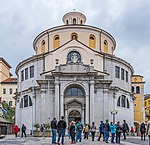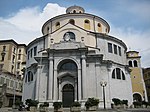Palace Modello

Palace Modello (Croatian: Palača Modello; Italian: Palazzo Modello) was built in 1885 in Rijeka, Croatia, on the place of the destroyed and demolished Adamichev (Croatian: Adamićev) theater. The palace was designed by the Viennese buro Fellner & Helmer led by Ferdinand Fellner and Herman Helmer. Building commenced in 1883 and completed in 1885. The palace was built for the Rijeka Bank and cashboxes of the Savings Banks. The Palace Modello has luxurious facade. It is rich in decorative elements in the style of the late renaissance and baroque. Decorative items were maden by the sculptor Ignazio Donegani.Modelo Palace is situated within sight of the Croatian National Theatre in honor Ivan Zajc, which was built in 1885 by the Buro Fellner & Helmer to replace the destroyed Adamichev theater.Attractive gala hall, which is now an audience of Italian Cultural Club (Italian: Comunità degli italiani di Fiume), decorated with magnificent stucco.The public library of Rijeka city is currently operating on the ground floor.
Excerpt from the Wikipedia article Palace Modello (License: CC BY-SA 3.0, Authors, Images).Palace Modello
Uljarska ulica, Grad Rijeka Mjesni odbor Luka (Rijeka)
Geographical coordinates (GPS) Address External links Nearby Places Show on map
Geographical coordinates (GPS)
| Latitude | Longitude |
|---|---|
| N 45.3253 ° | E 14.4436 ° |
Address
Palača Modello
Uljarska ulica 1/II
51000 Grad Rijeka, Mjesni odbor Luka (Rijeka)
Croatia
Open on Google Maps








